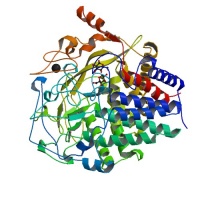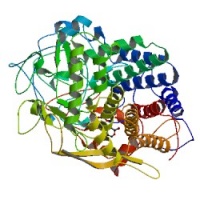CAZypedia needs your help! We have many unassigned GH, PL, CE, AA, GT, and CBM pages in need of Authors and Responsible Curators.
Scientists at all career stages, including students, are welcome to contribute to CAZypedia. Read more here, and in the 10th anniversary article in Glycobiology.
New to the CAZy classification? Read this first.
*
Consider attending the 15th Carbohydrate Bioengineering Meeting in Ghent, 5-8 May 2024.
Glycoside Hydrolase Family 48
This page has been approved by the Responsible Curator as essentially complete. CAZypedia is a living document, so further improvement of this page is still possible. If you would like to suggest an addition or correction, please contact the page's Responsible Curator directly by e-mail.
- Author: ^^^Bareket Dassa^^^
- Responsible Curator: ^^^Ed Bayer^^^
| Glycoside Hydrolase Family GH48 | |
| Clan | GH-M |
| Mechanism | inverting |
| Active site residues | Proton donor: known; Nucleophile: unknown |
| CAZy DB link | |
| http://www.cazy.org/fam/GH48.html | |
Substrate specificities
Family 48 glycoside hydrolases are major and key components of some cellulase systems, occurring in free enzyme systems (e.g., in Thermobifida fusca), multi-functional enzymes (e.g, in Caldicellulosiruptor saccharolyticus), anaerobic fungi (e.g., Piromyces equi) and every cellulosome system thus far described. The GH48 cellulase is commonly the most abundant enzyme subunit in cellulosome-producing bacteria. Each bacterium usually contains a single gene that codes for a GH48 enzyme, although a few bacteria (e.g., Clostridium thermocellum and Anaerocellum thermophilum) contain two or more GH48 genes. Of the two C. thermocellum GH48 enzymes, one (Cel48S) is a dockerin-containing cellulosomal enzyme, and the other (Cel48Y) is a free, non-cellulosomal enzyme that contains a cellulose-binding CBM3.
The following activities have been reported: endo-β-1,4-glucanase, chitinase, endo-processive cellulase and cellobiohydrolase. Its preferred substrate is amorphous or crystalline cellulose over carboxymethylcellulose (CMC), and its activity is strongly inhibited by the presence of cellobiose. Although its activity on various substrates is characteristically very low, it is thought to be a critically important enzyme which imparts a major component of synergy to its cellulase system.
Kinetics and Mechanism
The glycoside hydrolases of this family are inverting glycosidases, which preferentially attack the reducing end of the substrate [1].
The native and recombinant Cel48S from C. thermocellum displays typical characteristics of a processive exoglucanase [2], and its activity on amorphous cellulose is optimal at 70 °C and at pH 5–6.
Family 48 cellulases (i.e., CelS/S8 from C. thermocellum, Avicelase II of C. stercorarium) are stabilized at high temperatures by Ca2+ or other bivalent ions [3, 4, 5].
The Cel48F protein from C. cellulolyticum has been reported [6] to be a processive endo-glucanase, which performs a processive degradation of the cellulose chain after an initial endo-attack. A two-step mechanism was proposed [7], in which processive action and chain disruption occupy different subsites.
Catalytic Residues
The crystal structure of Cel48F, a cellulosome component of C. cellulolyticum, revealed the active center at the junction of the cleft and tunnel regions, where Glu55 is the proposed proton donor in the cleavage reaction, and the corresponding base was initially proposed to be either Glu44 or Asp230 [8].
The structure of the catalytic module of Cel48S of C. thermocellum showed a similar tunnel-shaped substrate-binding region formed by the alpha helices in the protein. The hydrolysis of the cellulose chain in Cel48S appeared to involve Glu87 (the equivalent of Glu55 in C. cellulolyticum Cel48F) as an acid to protonate the glycosidic oxygen atom and Tyr351 as a base to extract a proton from the nucleophilic water molecule that attacks the anomeric carbon atom.
More recent studies of Cel48F failed to unambiguously identity the catalytic base in the cleavage reaction [7].
Three-dimensional structures
Three-dimensional structures are available for two family 48 enzymes: Cel48F (from Clostridium cellulolyticum) and Cel48A (from Clostridium thermocellum). Both enzymes have an (α/α)6 barrel topology.
- 3D structures of GH48 proteins (click images for large versions)
3D structures of Cel48F in complex with different ligands are also available:
- with cellotetraose (1F9D)
- with the thio-oligosaccharide inhibitor PIPS-IG3 (1F9O)
- with cellobiose (1FAE)
- with cellobiitol (1FBO)
- with cellohexaose (1FBW)
- with a thio-oligosaccharide (1G9J)
- mutant E55Q with a thio-oligosaccharide (2QNO)
Family Firsts
- First sterochemistry determination
- Cellulomonas fimi CenE, described as an endo-β-1,4-glucanase, catalyzes the hydrolysis of cellohexaose with inversion of anomeric carbon configuration, characteristic of a single displacement reaction [11].
- First catalytic nucleophile identification
- …“Waiting patiently”… (see [12]).
- First general acid/base residue identification
- Glu was the proposed proton donor in the cleavage reaction [8].
- First 3-D structure
- The crystal structure of catalytic module of C. cellulolyticum Cel48F in complex with oligosaccharides [7].
- First cloning and sequencing
- The cel48S gene from C. thermocellum [13].
References
- Barr BK, Hsieh YL, Ganem B, and Wilson DB. (1996). Identification of two functionally different classes of exocellulases. Biochemistry. 1996;35(2):586-92. DOI:10.1021/bi9520388 |
- Guimarães BG, Souchon H, Lytle BL, David Wu JH, and Alzari PM. (2002). The crystal structure and catalytic mechanism of cellobiohydrolase CelS, the major enzymatic component of the Clostridium thermocellum Cellulosome. J Mol Biol. 2002;320(3):587-96. DOI:10.1016/s0022-2836(02)00497-7 |
- Bronnenmeier K, Rücknagel KP, and Staudenbauer WL. (1991). Purification and properties of a novel type of exo-1,4-beta-glucanase (avicelase II) from the cellulolytic thermophile Clostridium stercorarium. Eur J Biochem. 1991;200(2):379-85. DOI:10.1111/j.1432-1033.1991.tb16195.x |
- Morag E, Halevy I, Bayer EA, and Lamed R. (1991). Isolation and properties of a major cellobiohydrolase from the cellulosome of Clostridium thermocellum. J Bacteriol. 1991;173(13):4155-62. DOI:10.1128/jb.173.13.4155-4162.1991 |
- Kruus K, Wang WK, Ching J, and Wu JH. (1995). Exoglucanase activities of the recombinant Clostridium thermocellum CelS, a major cellulosome component. J Bacteriol. 1995;177(6):1641-4. DOI:10.1128/jb.177.6.1641-1644.1995 |
- Reverbel-Leroy C, Pages S, Belaich A, Belaich JP, and Tardif C. (1997). The processive endocellulase CelF, a major component of the Clostridium cellulolyticum cellulosome: purification and characterization of the recombinant form. J Bacteriol. 1997;179(1):46-52. DOI:10.1128/jb.179.1.46-52.1997 |
- Parsiegla G, Juy M, Reverbel-Leroy C, Tardif C, Belaïch JP, Driguez H, and Haser R. (1998). The crystal structure of the processive endocellulase CelF of Clostridium cellulolyticum in complex with a thiooligosaccharide inhibitor at 2.0 A resolution. EMBO J. 1998;17(19):5551-62. DOI:10.1093/emboj/17.19.5551 |
- Parsiegla G, Reverbel-Leroy C, Tardif C, Belaich JP, Driguez H, and Haser R. (2000). Crystal structures of the cellulase Cel48F in complex with inhibitors and substrates give insights into its processive action. Biochemistry. 2000;39(37):11238-46. DOI:10.1021/bi001139p |
- Guimarães BG, Souchon H, Lytle BL, David Wu JH, and Alzari PM. (2002). The crystal structure and catalytic mechanism of cellobiohydrolase CelS, the major enzymatic component of the Clostridium thermocellum Cellulosome. J Mol Biol. 2002;320(3):587-96. DOI:10.1016/s0022-2836(02)00497-7 |
- Shen H, Tomme P, Meinke A, Gilkes NR, Kilburn DG, Warren RA, and Miller RC Jr. (1994). Stereochemical course of hydrolysis catalysed by Cellulomonas fimi CenE, a member of a new family of beta-1,4-glucanases. Biochem Biophys Res Commun. 1994;199(3):1223-8. DOI:10.1006/bbrc.1994.1361 |
- Parsiegla G, Reverbel C, Tardif C, Driguez H, and Haser R. (2008). Structures of mutants of cellulase Cel48F of Clostridium cellulolyticum in complex with long hemithiocellooligosaccharides give rise to a new view of the substrate pathway during processive action. J Mol Biol. 2008;375(2):499-510. DOI:10.1016/j.jmb.2007.10.039 |
- Wang WK, Kruus K, and Wu JH. (1993). Cloning and DNA sequence of the gene coding for Clostridium thermocellum cellulase Ss (CelS), a major cellulosome component. J Bacteriol. 1993;175(5):1293-302. DOI:10.1128/jb.175.5.1293-1302.1993 |
- Steenbakkers PJ, Freelove A, Van Cranenbroek B, Sweegers BM, Harhangi HR, Vogels GD, Hazlewood GP, Gilbert HJ, and Op den Camp HJ. (2002). The major component of the cellulosomes of anaerobic fungi from the genus Piromyces is a family 48 glycoside hydrolase. DNA Seq. 2002;13(6):313-20. DOI:10.1080/1042517021000024191 |
- Zverlov V, Mahr S, Riedel K, and Bronnenmeier K. (1998). Properties and gene structure of a bifunctional cellulolytic enzyme (CelA) from the extreme thermophile 'Anaerocellum thermophilum' with separate glycosyl hydrolase family 9 and 48 catalytic domains. Microbiology (Reading). 1998;144 ( Pt 2):457-465. DOI:10.1099/00221287-144-2-457 |
- Fujita K, Shimomura K, Yamamoto K, Yamashita T, and Suzuki K. (2006). A chitinase structurally related to the glycoside hydrolase family 48 is indispensable for the hormonally induced diapause termination in a beetle. Biochem Biophys Res Commun. 2006;345(1):502-7. DOI:10.1016/j.bbrc.2006.04.126 |
- Xu Q, Bayer EA, Goldman M, Kenig R, Shoham Y, and Lamed R. (2004). Architecture of the Bacteroides cellulosolvens cellulosome: description of a cell surface-anchoring scaffoldin and a family 48 cellulase. J Bacteriol. 2004;186(4):968-77. DOI:10.1128/JB.186.4.968-977.2004 |
- Devillard E, Goodheart DB, Karnati SK, Bayer EA, Lamed R, Miron J, Nelson KE, and Morrison M. (2004). Ruminococcus albus 8 mutants defective in cellulose degradation are deficient in two processive endocellulases, Cel48A and Cel9B, both of which possess a novel modular architecture. J Bacteriol. 2004;186(1):136-45. DOI:10.1128/JB.186.1.136-145.2004 |
- Sánchez MM, Pastor FI, and Diaz P. (2003). Exo-mode of action of cellobiohydrolase Cel48C from Paenibacillus sp. BP-23. A unique type of cellulase among Bacillales. Eur J Biochem. 2003;270(13):2913-9. DOI:10.1046/j.1432-1033.2003.03673.x |
- Irwin DC, Zhang S, and Wilson DB. (2000). Cloning, expression and characterization of a family 48 exocellulase, Cel48A, from Thermobifida fusca. Eur J Biochem. 2000;267(16):4988-97. DOI:10.1046/j.1432-1327.2000.01546.x |

